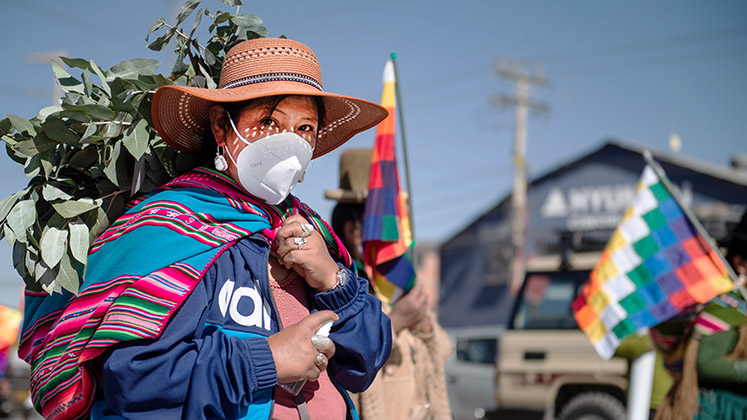It is not easy to find records of peasant and indigenous women’s participation in contested politics in Peru. But the current access to technology and the Internet allows us to witness, in real-time, the multiple ways in which peasant and indigenous women face violence, racism and discrimination due to their political participation. Mercedes Crisóstomo (University College London – Institute of the Americas) has recently explored these topics in her thesis and compares these movements to the current social unrest in Peru.
Lee este post en español
On 4 February 2023, Aida Aroni Chilcce, a Quechua-speaking woman born in the Huancapi district of Ayacucho but displaced in Lima due to the internal armed conflict (1980-2000), together with other demonstrators, went to the streets to protest Dina Boluarte’s authoritarian government. In a video of the demonstration, it is possible to observe that before her detention, Aida was waving a Peruvian flag and using a megaphone to complain about Boluarte and the police’s repression of the protests. The video showed Aida was in the middle of thousands of marchers and a shielded police cordon. Minutes after, the police snatched her flag and arrested her violently while she was also imploring them not to throw tear-gas bombs.
After two days of arbitrary incarceration, the police released her. Outside the police station, in an interview with a journalist, Aida, speaking in Quechua, sent a message to Boluarte, saying, “you are making suffer your people. Why are you doing this? Is this for money? Maybe you do not realise, but as people put presidents, people will throw them too.” She also stressed: “I do not walk carrying a stone, I do not side with vandalism, I just carry my red and white Peruvian flag”. The protests in which Aida is participating broke out after President Pedro Castillo, a rural schoolteacher, and unionist, was removed from power after he closed the Parliament and proclaimed a government of exception. Boluarte, as his vice president, replaced him.
Protests in the 1960s
In July 1961, hundreds of peasants from La Convención province travelled to Cuzco to protest their oppressive working conditions in the haciendas. When they arrived at the city’s main square, military troops surrounded and aimed their weapons at them. One frightened peasant fled, leaving behind a Peruvian flag. Carmela Giraldo, a Quechua-speaking peasant leader, unionist, and communist, wrapped herself around the flag. Followed by other female protestors, she confronted the troops and made them drop their weapons, allowing the protestors to continue marching to the prefecture, where they presented their complaints. In the 1960s, together with prominent local and national leftists and unionists, Carmela spoke out to demand agrarian reform, justice, and peasant liberation in rallies and protests.
In this period, other women from urban, peasant and indigenous backgrounds, like Carmela Giraldo, joined political movements and revolutionary projects, aiming to fight imperialism and abusive power holders. As I explain in my PhD dissertation ‘Women in the Peruvian Revolutionary Left: Militancia and Post-Militancia in Cuzco and Ayacucho’, they backed ending poverty, exclusion, and subordination, which peasant indigenous peoples had historically endured.
Before Carmela and Aida, other peasant indigenous women like María de la Paz Chanini, Nicasia Yabar and Rosalia Larico became “indigenous messengers” in the early twentieth century. As such, they travelled from the rural communities of Puno to Lima to present formal requests to the state. Despite their illiteracy and poor fluency in Spanish because they mainly spoke Aymara and Quechua, they successfully formulated their petitions to the national government.
María, Nicasia, and Rosalia framed their grievances about the conscription of men, local authorities’ abuses, and usurpation of their lands highlighting their roles as mothers and appealing to the fatherhood of the president as strategies to get justice. These women became icons of the indigenista artistic movement (1920) since they worked as models for the newly created School of Fine Arts led by the painter José Sabogal, who started the Indigenist movement in the arts. In addition, these women managed to interact with members of first-wave feminism, communism, and indigenismo of the early twentieth century.
Carmela, Aida, María, Nicasia and Rosalia’s participation in Peruvian contested politics and social movements shed light on peasant indigenous historical participation in political issues and the ways they have contributed to building and enhancing democracy and politics. Women, particularly peasant and indigenous, have mobilised to protest their exclusion and demand social justice throughout history in alliance with peasants, students, and worker organisations. They have protested by carrying out their traditional gendered roles, such as cooking and providing care to injured people, but also by marching, speaking out, leading, and organising mobilisations and strikes against what they perceived as an unfair social order. Paraphrasing the political scientist Sidney Tarrow, these women have spoken throughout their actions.
A sense of collectiveness
Women like Carmela and Aida have contributed to building democracy by enlarging the notions of politics and “practising” it. First, peasant and indigenous women have expanded the meaning of politics by giving it (or returning to it) a sense of collectiveness. The experiences of Carmela Giraldo and the female indigenous messengers suggest that they had marched because they represented the voices of their rural communities and organisations and their own sense of indignation.
Since women in general, and peasant and indigenous women in particular, have been historically neglected from political participation and public spheres, the sole fact that they were, and are, able to speak out in Quechua, Aymara or an Amazonian native language or lead marches or challenge the army and the police put them the centre of the political stage.
Their participation in contested politics and social movements openly defied the historical discrimination of indigenous peoples from politics and simultaneously reconfigured their identity and notion of citizenship.
I argue that by “speaking through their actions”, women like Carmela, María or Aida have enlarged the notion of democracy and politics in the past. But currently, they face violent police and military repression, judiciary persecution and accusations of terrorism.
Historical repression
In the past, records of peasant and indigenous women’s participation in contested politics are rare or even impossible to find. Today, access to technology and the Internet allows us to witness, in real-time, the multiple ways in which peasant and indigenous women faced violence, racism and discrimination also due to their political participation. The repression and violence these women are suffering in the hands of the police and the military allow us to have a hint of the scale of the violence that male and female peasants had experienced throughout history while demanding the devolution of their usurped land as well as while asking rights, education, and the presence of the state.
For the past two months, Aida and other women and men like her, together with thousands of students, unionists, and activists, still are in the Peruvian streets and main squares voicing their indignation against the brutality of the police and the military, the authoritarianism of the government and the Parliament. They are demanding new elections and hoping to finally have someone in power who would rule to provide social justice, equality, redistribution, and inclusion to all Peruvians and not only to a few privileged ones.
Notes:
• The views expressed here are of the author rather than the Centre or the LSE
• Please read our Comments Policy before commenting
• Women in the Peruvian Revolutionary Left: Militancia and Post-Militancia in Cuzco and Ayacucho examines Peruvian women’s militancia (militancy) in revolutionary parties during the 1960s and 1970s as well as their post-militancia in the current time.
• Banner image: A peasant woman protests in Lima in January 2023 against president Dina Boluarte / Joel Salvador (Shutterstock)





